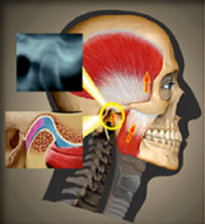If determining the causes of TMJ Disorders was a relatively straight forward process, the myriad of scientific studies that have been done would have long ago spelled them out. How do we explain the interplay of a wide variety of factors that can influence whether a non-symptomatic individual may develop a temporomandibular disorder?
Dr. Jeffery Okeson has proposed a model that considers all of the potential contributing factors to the development of TMDs:
- • Dental Occlusal Factors
- • Trauma (Macro and Micro)
- • Emotional Stress
- • Deep Pain Input
- • Parafunction
It is common for a patient with a TMD to display more than one of these potential contributing factors, referred to as a multi-factorial causation.
There are also possible factors that may weigh against the development of disorders and diseases, including TMDs. These are related to the individual’s “adaptability” or “physiologic tolerance” and may include:
- • Genetic factors
- • Biologic factors
- • Hormonal factors
- • Generally robust health and immune system
- • Possibly others?
One of the major difficulties in identifying a “cause” or “causes” of TMD in any individual patient is that neither the contributing factors nor the factors that constitute a person’s “adaptability” are quantifiable. This makes doing scientific studies especially challenging.
Therefore, in an individual with a robust “adaptability”, in spite of the presence of one or more significant potential contributing factors, the individual may not develop a TMD. In another individual, perhaps with a similar complex of potential contributing factors, but with a diminished “adaptability”, the development of a TMD may occur. Onset may occur acutely, in response to a triggering mechanism, or it may occur insidiously and appear without an apparent trigger.
In a patient in whom a triggering mechanism appears to have been present, it would be easy to attribute the development of the TMD to the triggering mechanism, alone. However, it is also possible that the patient had been predisposed to the onset. Although signs or symptoms may not have been apparent, the presence of any of the contributing factors listed above, prior to the onset of symptoms, might have played a role in predisposing the patient. For more on contributing factors, see “Contributing Factors in TMD Causation”. A triggering mechanism may have simply pushed the patient beyond their individual “adaptability” threshold and may have been no more than the “straw that broke the camel’s back”.
In considering treatment of such an individual, it is important to be aware of possible predisposing factors that may have contributed to the onset. These will often become apparent with a thorough history and examination. As is true with many health issues, there is an on-going dynamic relationship between contributing factors and adaptive factors.
Development of “Chronic” TMD
Okeson further suggests how a TMD, which initially may develop as an acute problem, might progress into a true chronic pain condition. Two possible factors that can act separately or, in some instances in combination, may contribute to the evolution of acute pain to true chronic pain.
The first possibility is that the patient’s “adaptability” may be further lowered, perhaps by other systemic factors such as chronic illness or an increase in stress levels. The second possibility is that, in the absence of appropriate or adequate treatment, an initially acute source of dysfunction and pain might persist and lead to a prolonged pain input to the CNS, leading to activation of what are known as “central mechanisms.” These include:
- • Altered hypothalamic-pituitary-adrenal (HPA) axis function
- • Increased central sensitization
- • Decreased descending inhibition
It is also recognized that, with the development of true pain chronicity, there is often a change at the emotional or psychological level in response to the ongoing pain. In fact, this type of emotional change is recognized as one of the hallmarks of chronic pain.
Finding Answers to the Causation Enigma
A statement from Dr. Charles Greene is worth consideration: “this term (multi-factorial) often is a cover-up for the word ‘idiopathic’”. The largest challenge to finding a solidly scientific resolution regarding the causation of TMDs is the fact that most, if not all, of the acknowledged contributing factors cannot be easily quantified. When factors involved in a scientific hypothesis cannot be measured, testing the hypothesis becomes, if not impossible, a true enigma. To read more, go to the “Contributing Factors in TMD Causation” page.
The causation of TMDs is clearly seldom the result of a single factor but a complex and dynamic process that is almost certainly different in each patient. As dental clinicians, for whom management of the masticatory system is a primary professional responsibility, we should recognize that the clinical evidence for a significant occlusal component to this complex picture, in most patients, cannot be dismissed and requires thoughtful consideration in each patient.

